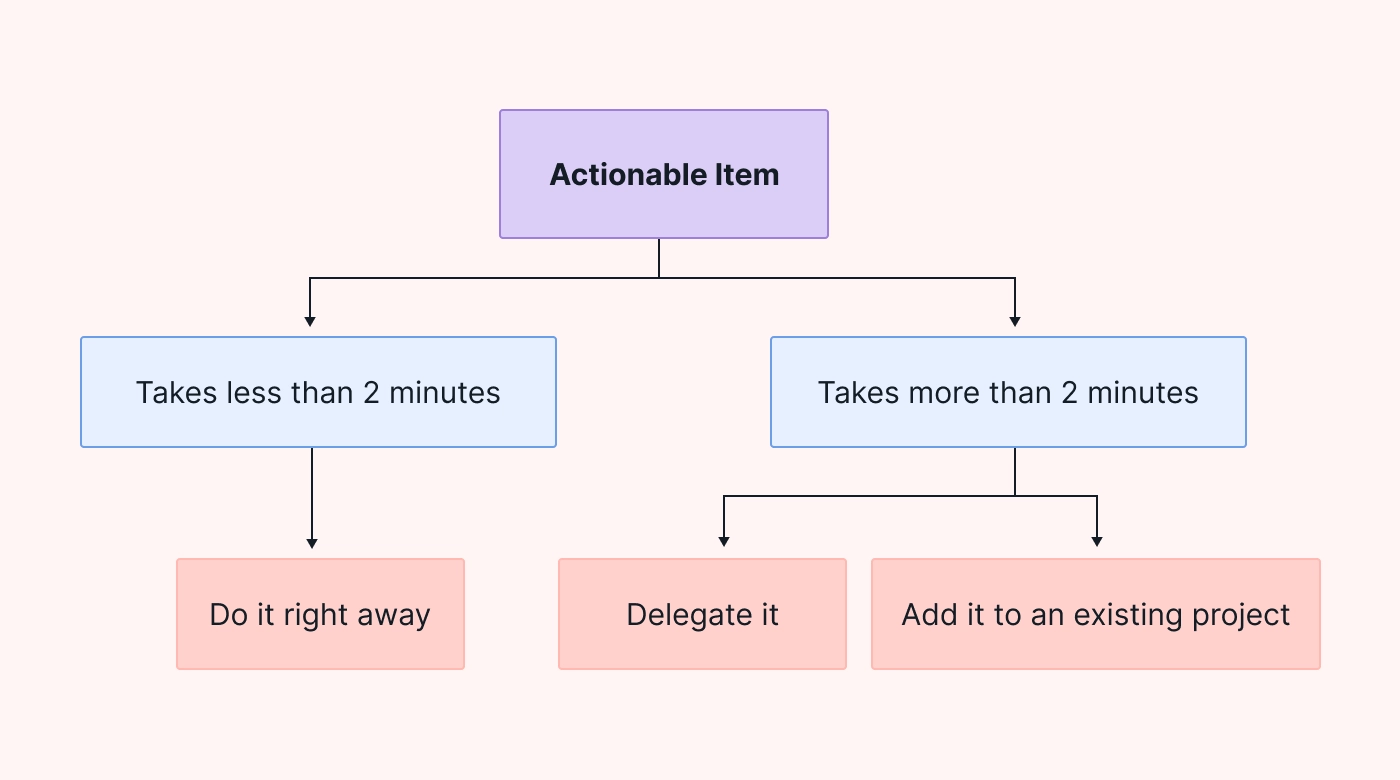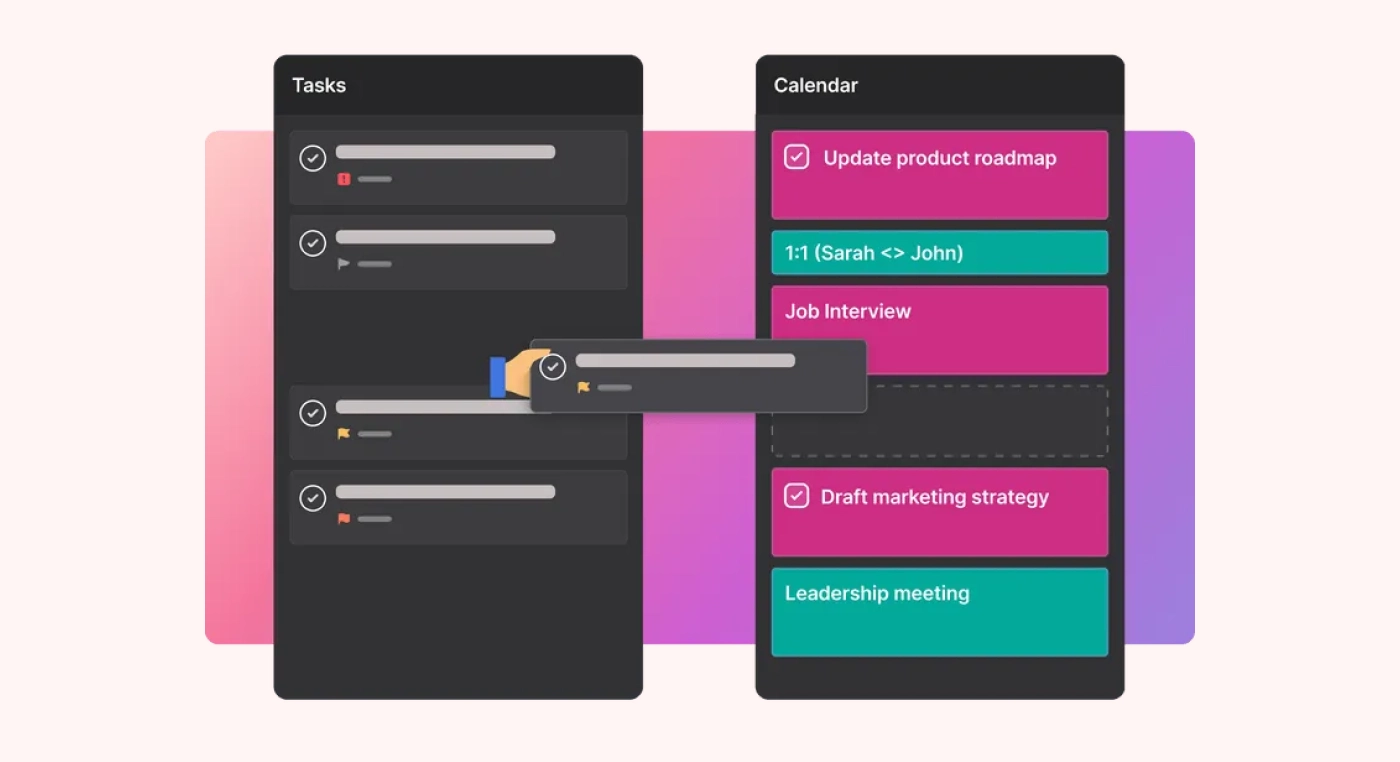Have you ever found yourself wondering where your time went at the end of a busy day?
In today’s fast-paced world, it's easy to lose track of time.
So, what’s the best way to reclaim control over your time when so many great and small things clamor for your attention, both at work and at home?
There are dozens of useful time management tools, but one of the easiest to implement and get results with is the 2-minute rule.
The 2-minute rule is a method for quickly dealing with the small stuff so you can better manage the big stuff.
This article explains how this rule works, how it fits into workflow management, and what not to do so you can get the most out of it.
What is the 2-minute rule?
The two-minute rule is a concept from David Allen’s workflow management method called Getting Things Done (GTD). In a nutshell, this rule states that if you face a task that can be completed in two minutes or less, you should do it immediately rather than postponing it or adding it to your to-do list.
We’ll go into more detail on GTD later.
By promptly addressing small tasks, you prevent them from accumulating in your head or on your desk.
Quickly dealing with small tasks and getting them out of the way also helps you maintain focus and be more productive. The reality is that small tasks can turn into distractions that interrupt your more significant work, especially if they pile up.
By dealing with these tasks immediately, you can keep your to-do list and your mind clearer. That way, you can concentrate better on more complex or time-consuming responsibilities.
What are the benefits of using the 2-minute rule?
The most important benefit of the 2-minute rule is better productivity.
How does it make you more productive?
You’re not constantly faced with random small or unimportant things. As a result, you have more mental space for focused work.
The average office worker is far from productive due to distractions and a lack of focus. In fact, a recent study found that during an 8-hour workday, the average worker only spends 4 hours and 12 minutes actively working. Ouch!
So, what are these workers doing for the rest of their time at the office?
Well, there are the usual office distractions, such as chatting with colleagues about personal things, watering the plants, or sauntering over to the kitchen for a snack or a nice cup of coffee.
But more importantly, there are unproductive habits related to not really locking into the work at hand but finding seemingly justifiable ways to procrastinate.
For instance, the study above also mentioned that a whopping 47% of employees surf the internet for personal reasons, such as reading online news, for an average of 65 minutes per work day.
 |
The 2-minute rule can’t solve these poor work habits and non-productive behaviors all by itself, but it can help employees get a better grip on the daily distractions that contribute to a mind that wants to focus on anything but the task at hand.
To sum it up, by decluttering your mind with the 2-minute rule, you leave fewer small things hanging. You then stay focused on more significant projects since your mind isn’t constantly wandering to your long list of uncompleted minor tasks and the stress associated with ignoring or constantly postponing them.
So, how do you use the 2-minute rule to tap into these benefits? Let’s take a look.
How does the 2-minute rule work?
To fully grasp how the 2-minute rule works, it’s important to look at it in a broader context: through David Allen’s GTD methodology.
GTD is a comprehensive approach to productivity and time management. It focuses on the idea of moving planned tasks and projects out of your mind by recording them externally (either on paper or electronically) and then breaking them into actionable work items.
This reduces the mental stress of keeping too many big and small projects in your head all at once.
Within the GTD framework, the 2-minute rule is a guideline for how to deal with smaller tasks rather than recording them on some kind of a to-do list.
The rationale is that it usually takes more time to capture these small tasks on a list and try to get back to them later than simply doing them while they’re right in front of you and have your attention anyway.
 |
By tackling these quick tasks on the spot, you can reduce your backlog of minor tasks that would otherwise occupy your brain (too many small things to keep in your memory bank at once) and your physical space (too many sticky notes and project files lying around on your desk).
What about habit-building with the 2-minute rule?
While the decluttering power of the 2-minute rule is obvious, you may have also heard of the 2-minute rule mentioned in the context of habit formation. This concept was promoted by James Clear in his bestselling book Atomic Habits.
Clear’s interpretation of the 2-minute rule is as follows: “When you start a new habit, it should take less than two minutes to do.”
The thinking here is that when you want to start something new and build a good habit to sustain it, it’s helpful to break the task down into tiny bits you can do in two minutes each.
For instance, dusting your house can take anywhere from 15 minutes to over an hour, depending on the size of your dwelling. Many people put off a task like this because, to them, it takes up too much time when they have to do it all at once.
But when you break this task down into 2-minute fragments, the picture changes.
To activate the 2-minute principle, you could put a dusting cloth in a place where you’ll see it — in the laundry room, for instance. Then, whenever you walk past that spot during the day, you pick the cloth up and dust for two minutes.
There are some beneficial psychological effects of doing this.
First of all, you’ll see results fairly quickly (“Look, honey, the house is getting cleaner!”), which will motivate you to continue.
Secondly, once you start picking up that dusting cloth for two minutes several times a day, you’ll begin to build a better dusting habit within a reasonable time. You’ll start thinking, “I’ve been dusting for two minutes, so why not do another five or ten and finish the job?”
So, consistently investing in two minutes of habit formation will gradually whittle down any procrastination momentum you may have. It will give you a stronger motivation for projects you would like to tackle but have put off for too long.
What are the drawbacks of the 2-minute rule?
Though the 2-minute rule can boost people’s efficiency, it can backfire as well if not used as intended. Here’s how:
If you constantly prioritize all kinds of quick 2-minute tasks over substantial, meaningful work and big projects, the day may slip away with little to show for it in terms of significant production or progress.
Misalignment between the intent of this method and how many people actually use it can lead to a false idea of productivity. Completing many two-minute tasks may give you a sense of fulfillment but ultimately doesn't contribute a whole lot to your long-term goals.
As an example, imagine an employee who embraces the 2-minute rule the wrong way and primarily spends the day staying on top of an overcrowded email inbox.
Most of these emails take less than two minutes to scan through, respond to, star for future action, or delete. While the person’s inbox will look neat at the day’s end, their more pressing projects will languish from a lack of attention.
 |
This scenario shows how misunderstanding the 2-minute rule can lead to unproductive days — and how this rule itself can, unintendedly, become a justification for procrastination.
How to use the 2-minute rule effectively
So, how do you use the two-minute rule as it’s intended?
The important thing is to understand how, in the broader context of Allen’s GTD method, the 2-minute rule isn’t an isolated tactic but part of a holistic workflow process.
Here’s how this works:
In any work or personal setting, random “stuff” comes your way all the time.
When you’re confronted with one of these random things to do, your first step is to identify what it is and immediately decide whether it’s actionable.
If it’s not actionable or important, you’ll file it in the appropriate file folder, hold onto it to do later, drop it into the trash can, or delete it from your inbox.
On the other hand, if the item is actionable and important, you’ll decide on the next action. Here’s where the 2-minute rule kicks in:
- If the action will take less than two minutes to complete, do it right away.
- If you realize it will take longer than that, either delegate it or integrate it into an existing work project.
 |
By applying the 2-minute rule in this systematic way, you’ll consistently assess the impact of completing small tasks against the backdrop of your larger projects. As you sift through your daily tasks, your immediate focus will always be on projects that are both urgent and important.
Advanced task management with AI-driven tools
A particularly nice benefit of using the 2-minute rule is that you screen out a lot of small daily tasks that don’t need inputting into your to-do list.
But what about the remaining tasks — the ones that do end up on your “do soon or later” project list?
An AI-driven task management tool like Motion’s Task Manager can make staying on top of these tasks easier than keeping track of them on paper or in electronic file folders.
The Task Manager is designed to intelligently organize tasks, prioritize them based on deadlines and personal work habits, and even suggest optimal times for tackling specific tasks.
 |
The Task Manager is designed to intelligently organize tasks, prioritize them based on deadlines and personal work habits, and even suggest optimal times for tackling specific tasks.
With a tool like this, you can break down large projects into manageable actions and set reminders for deadlines. Motion even rearranges your schedule automatically as your priorities shift.
This nicely complements the GTD method by efficiently handling tasks that require more than a quick decision — those that need careful planning and sustained effort over time.
There are several benefits to integrating AI-driven tools like Motion’s Task Manager with GTD principles:
- You can easily track progress on long-term goals so that your time is allocated effectively. True to the GTD principle, this reduces the cognitive overload you experience when constantly having to decide what to do next.
- Motion’s Task Manager also introduces a new level of data-driven insights into your personal productivity habits to help you better understand your performance patterns and optimize your schedule for peak efficiency.
In short, while the 2-minute rule is excellent for handling smaller tasks quickly and efficiently, AI-driven tools are a great help for managing more complex, longer-term, or time-consuming tasks. Think of them as a personal assistant who makes sure that all your tasks are always aligned with your ultimate productivity goals.
Build on the 2-minute rule with Motion
David Allen’s 2-minute rule is useful for dealing quickly with many of the small tasks that constantly come across your desk.
However, it’s easy to misunderstand this concept and use it to justify procrastinating on the bigger stuff. This can hinder rather than help your productivity — so use it wisely.
Motion’s AI-driven Task Manager can be a powerful workflow assistant for tasks and projects that fall outside of the 2-minute rule. To find out how, try Motion for free for 7 days.

A certified content writer and SEO strategist, Carla Groenewegen writes about success principles and practices aimed at SMBs and not-for-profit organizations.




